Higher classification Sea Cow Rank Species | Phylum Chordata Order Sea cows | |
 | ||
Similar Sea cows, Mammal, Dugongidae, Dugong, Great auk | ||
Skin bones animal life steller s sea cow
Steller's sea cow (Hydrodamalis gigas) is an extinct species of sirenian that was discovered in 1741. At the time of its discovery, it was found only in the Commander Islands, which are situated in the Bering Sea between Alaska and Russia. Its closest living relative is the dugong (Dugong dugon), which is the sole surviving member of the Dugongidae, of which Steller's sea cow was also a part. It was among the largest mammals other than whales to have existed into the Holocene epoch, reaching weights of 8–10 metric tons (8.8–11.0 short tons) and lengths of 9 metres (30 ft).
Contents
- Skin bones animal life steller s sea cow
- Description
- Ecology and behavior
- Phylogeny
- Research history
- Illustrations
- Range
- Extinction
- Later sightings
- Commercial value
- Portrayals in media
- References

Steller's sea cow was the largest of all sirenians, and had a much thicker layer of blubber than other sirenians; this was an adaptation to the cold waters of its environment. The tail was forked, like that of cetaceans. Instead of teeth, it had an array of white bristles on the upper lip, and two keratinous plates used for chewing. It fed mainly on kelp. The sea cow was mute and made snorting sounds and sighs. It was apparently monogamous and gregarious, and lived in small family groups; it probably cared for its young, like extant sirenians.
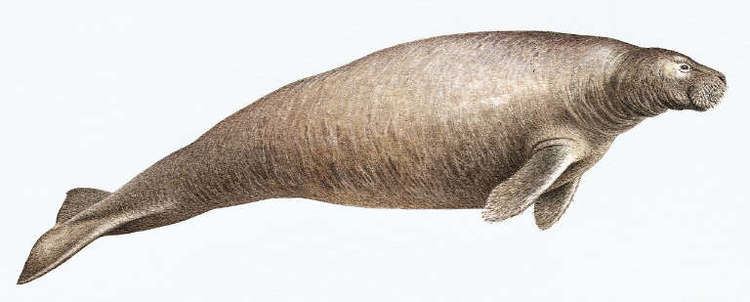
Georg Wilhelm Steller, a naturalist, discovered Steller's sea cow in 1741 on Vitus Bering's Great Northern Expedition when he and his crew were shipwrecked on Bering Island. Much of what is known about the sea cow in life comes from Steller's account on the island documented in his posthumous publication "The Beasts of the Sea". Within 27 years of discovery by Europeans, the slow-moving and easily captured Steller's sea cow was hunted into extinction for its meat, fat, and hide, though sightings have been claimed after 1768.
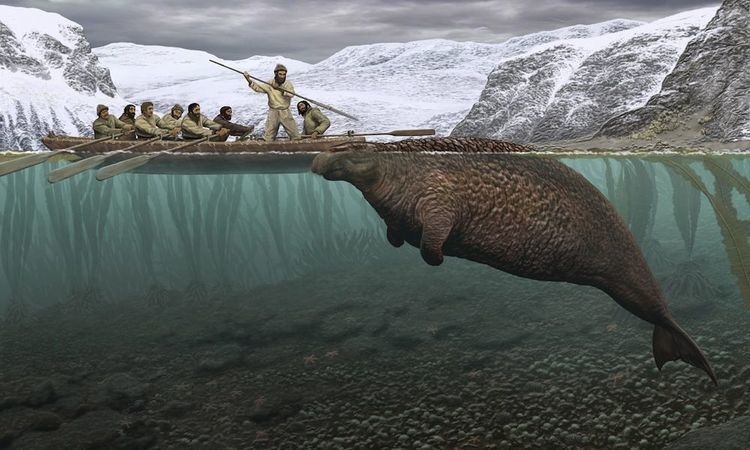
Description
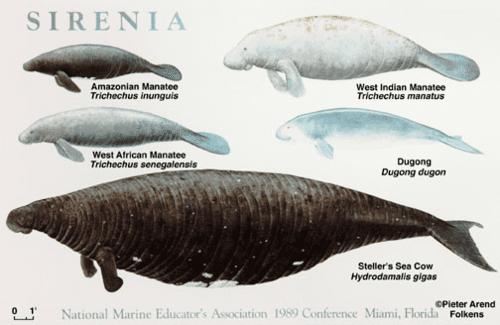
Steller's sea cow grew to be 8 to 9 m (26 to 30 ft) in length as an adult, much larger than extant sirenians; however, the naturalist Georg Steller's work contains two contradictory weight estimates: 4 and 24.3 metric tons (4.4 and 26.8 short tons). The true value is estimated to lie between these figures, at about 8–10 metric tons (8.8–11.0 short tons), making it one of the largest mammals of the Holocene epoch, besides whales. Its large size was probably an adaptation to reduce its surface-area-to-volume ratio and conserve heat. Unlike other sirenians, Steller's sea cow was positively buoyant, meaning it could not completely submerge. It had a massive epidermis, 2.5 centimetres (0.98 in) in thickness, to prevent injury from abrasions on sharp rocks and ice, and possibly to prevent the skin that was not submerged from drying out. The blubber was 8–10 centimetres (3.1–3.9 in) thick, an adaptation to the cold climate of its habitat. The skin was brownish-black in color, with white patches in some individuals. It was smooth along the back and rough on the sides, with crater-like depressions most likely from ectoparasites; alluding to its rough skin texture, the animal has also been called the "bark animal". Hair was sparse, but the inner sides of the flippers were covered in bristles. The tail fluke was forked, like that of cetaceans; the forelimb was ca. 67 centimetres (26 in) long.
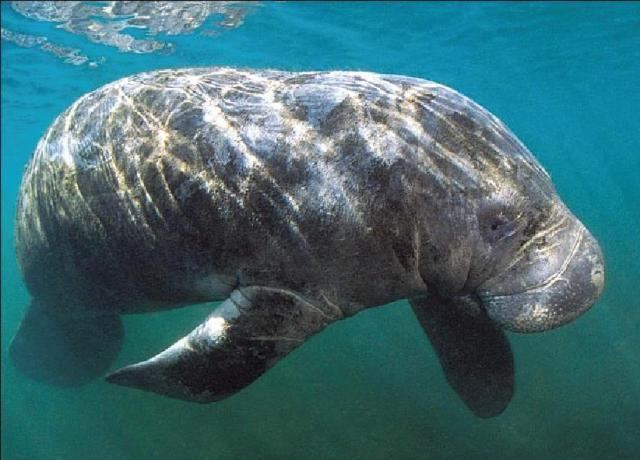
Its head was small and short compared to the huge body. The upper lip was large and broad, and extended so far beyond the mandible that the mouth appeared to be located underneath the skull. Instead of teeth as in other sirenians, Steller's sea cow had a dense array of interlacing white bristles on the upper lip, 3.8 centimetres (1.5 in) long, which were used to pull out seaweed and hold food, and used two keratinous plates located on the palate and mandible for chewing. According to Steller, these plates, or "masticatory bones", were held together by interdental papillae, a part of the gums, and had many small holes for nerves and arteries. The snout was pointed downwards, as in all sirenians, to better grasp kelp, and stiff, 10–12.7 centimetres (3.9–5.0 in) long bristles were protruding from the muzzle. The nostrils were 5 centimetres (2 in) long and wide, and located at the tip of the rostrum. The small eyes were parallel to the nostrils, located halfway between the nostrils and the ears, and, like other sirenians, it used sphincters (muscles) to close its eyes as opposed to eyelids. The irises were black, the eyeball was livid, and the canthi, the corners of the eye, were not visible externally. Like other diving creatures, such as the sea otters, Steller's sea cow had a nictitating membrane which covered the eye to prevent injury while feeding. It had no eyelashes. Its tongue was rough with lingual papillae, small structures on the tongue that give it texture; it was 30 centimetres (12 in) long and kept in the back of the mouth.

As in all sirenians, the scapula of Steller's sea cow was fan-shaped, that is, larger on the posterior side and narrower towards the neck. The anterior border of the scapula was nearly straight, whereas that of modern sirenians is curved. Like most sirenians, the bones of Steller's sea cow were pachyosteosclerotic, being both bulky (pachyostotic) and dense (osteosclerotic). In all collected skeletons, the manus is missing. Since Dusisiren, the sister taxon of Steller's sea cow and other Hydrodamalis, had reduced phalanges (finger bones), it is possible that Steller's sea cow did not have a manus. The gallbladder was absent, but it did have a common bile duct.
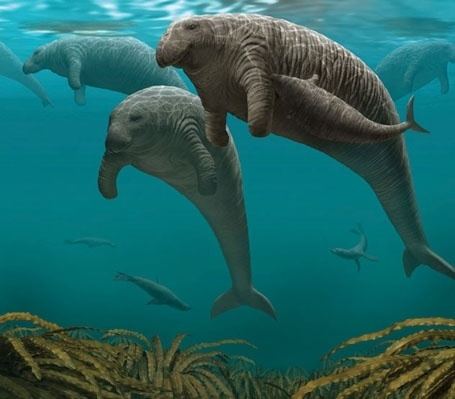
Steller's sea cow was mute, according to Steller, making only heavy breathing sounds, raspy snorting similar to a horse, and sighing.
Ecology and behavior
Whether or not Steller's sea cow had any predators is unknown. It may have been hunted by killer whales and sharks, but its buoyancy may have made it difficult for killer whales to drown it, and the rocky kelp forests may have protected it from sharks. According to Steller, the young were guarded by the adults from predators. Steller described an ectoparasite on Steller's sea cow which was similar to the whale louse (Cyamus ovalis); the parasite remains unidentified as the host has gone extinct and the original specimens he collected are lost. Apparently, these parasites were picked off the sea cows by seagulls in a symbiotic relationship. Steller also identified an endoparasite, but this was probably an ascarid nematode.
Like other sirenians, Steller's sea cow was an obligate herbivore, and kelp was most likely its main food source (algivore). It probably foraged on a few species of kelp, which have been identified as Agarum spp., Alaria praelonga, Halosaccion glandiforme, Laminaria saccharina, Nereocyctis luetkeana and Thalassiophyllum clathrus. It only attacked the soft parts of the kelp, and consumed the tougher stem and holdfast when they washed up on shore in heaps. It may have also fed on seagrass, but this did not occur in sufficient quantities to support a viable population, and so could not have been the main food source. Also, the available seagrasses in their range, Phyllospadix spp. and Zostera marina, were probably too tough or occurred too deep for Steller's sea cow to consume. Since the sea cow floated, it probably fed on canopy kelp, as it could have only accessed food that was no deeper than 1 metre (3.3 ft) below the tide. Kelp release a chemical deterrent to prevent grazing, but canopy kelp release a lower concentration, allowing the sea cow to graze without developing resistance. Steller noted that it grew thin during the frigid winters, indicating a period of fasting due to low kelp growth. Fossils of Pleistocene Aleutian Island sea cow populations were larger in size than those in the Commander Islands, suggesting that the growth of Commander Island sea cows was stunted due to the marginalized environment with a less favorable habitat, and therefore less food, than the warmer Aleutian Islands.
Steller described the sea cow as being gregarious and highly social. It lived in small family groups and helped injured members, was apparently monogamous, and may have exhibited parental care. Steller noted that a group of sea cows attacked a hunting boat by ramming and rocking it while a female was being captured, and that after the hunt, her mate followed the boat to shore, even after she died. Gestation took a little over a year, and it is likely that calves were usually delivered in autumn, as Steller noted that he observed a greater number of calves in autumn than at any other time of the year. Since only one set of mammary glands was present, females probably had one calf at a time.
The forelimbs, according to Steller, were used as a sort of holdfast to anchor the sea cow down to prevent being swept away by the strong nearshore waves around its habitat. To sleep, it went further out to sea to prevent beaching itself when the tides receded.
Phylogeny
Steller's sea cow was a member of the genus Hydrodamalis, a group of large sirenians, whose sister taxon was Dusisiren. Much like those of Steller's sea cow, the ancestors of Dusisiren were associated with tropical mangroves, and subsequently adapted to the cold climates of the North Pacific and to consuming kelp. Hydrodamalis and Dusisiren are classified together in the subfamily Hydrodamalinae. Steller's sea cow is a member of the family Dugongidae, whose sole surviving member, and thus Steller's sea cow's closest living relative, is the Dugong (Dugong dugon).
Steller's sea cow was a direct descendant of the Cuesta sea cow (H. cuestae), an extinct tropical sea cow of California. The Cuesta sea cow most likely went extinct due to the onset of the Ice Ages and the subsequent cooling of the oceans; lineages which could not adapt died out, and those that could started the lineage of Steller's sea cow. The Takikawa sea cow (H. spissa) of Japan is thought of by some authors to be a synonym of the Cuesta sea cow; however, based on a comparison of endocasts, the Takikawa sea cow and Steller's sea cow are more derived than the Cuesta sea cow, and thus the Takikawa sea cow is possibly a separate species. The evolution of Hydrodamalis was characterized by an increasing size and the loss of teeth and phalanges as a response to the onset of the Ice Ages.
Research history
Steller's sea cow was discovered in the mid-18th century by Georg Wilhelm Steller, and subsequently named after him; Steller studied the local wildlife of Bering Island, including a relict population of sea cows, sea otters, Steller sea lions, and northern fur seals, while he was shipwrecked there. His account was written in his posthumous publication De bestiis marinis, or "The Beasts of the Sea", which was published by the Russian Academy of Sciences in St. Petersburg, Russia in 1751. Zoologist Eberhard August Wilhelm von Zimmermann had described its specific name as gigas in 1780, but placed it in the genus Manati. Biologist Anders Jahan Retzius placed it under the genus Hydrodamalis, but described its specific name as stelleri, as Steller was the first person to describe it. In 1811, naturalist Johann Karl Wilhelm Illiger placed Steller's sea cow under the genus Rytina, which many writers at the time adopted, even though the animal had already been classified long before this. The name Hydrodamalis gigas was first used in 1895 by Theodore Sherman Palmer.
For decades after its discovery, no osteological evidence, or skeletal remains, of the existence of Steller's sea cow was discovered. This may be due to wrongly-identified remains, and rising and falling sea levels over the course of the Quaternary, which may have left many sea cow bones unexposed. The first Steller's sea cow bones were unearthed in about 1840, over 70 years after it was presumed extinct. The first partial skull was discovered in 1844 by Ilya Voznesensky after spending two days in the Commander Islands, and the first skeleton in 1855 in northern Bering Island. It was sent to the Russian Academy of Sciences in St. Petersburg in 1857, and another nearly complete skeleton arrived in Moscow around 1860. Most of the skeletal remains were unearthed in the late 1800s; in the period between 1878 and 1883, 12 of the 22 skeletons (with a known time of collection) were discovered. Adolf Erik Nordenskiöld, Benedykt Dybowski, and Leonhard Hess Stejneger unearthed many large bones from different individuals during this time period, from which complete skeletons were assembled. As of 2006, 27 nearly complete skeletons and 62 complete skulls exist.
Illustrations
The Pallas Picture is the only known drawing of Steller's sea cow from an actual specimen. It was published by Peter Simon Pallas in his 1840 work Icones ad Zoographia Rosso-Asiatica. Pallas did not specify a source; Stejneger suggested it might be one of the original illustrations produced by Friedrich Plenisner, who was onboard Vitus Bering's crew as a painter and surveyor, of a female specimen, drawn at Steller's request. Most of the other drawings by Plenisner were lost in transit from Siberia to St. Petersburg. Another drawing of Steller's sea cow similar to the Pallas Picture was drawn in 1744 by Sven Waxell and Sofron Chitrow on a map, possibly from a specimen, and published in 1893 by Pekarski. The map depicted Vitus Bering's route in the Great Northern Expedition, and featured illustrations of Steller's sea cow and Steller's sea lion in the upper-left corner. However, the drawing contains some inaccurate features, such as the inclusion of eyelids and fingers, and may be based on the Pallas Picture rather than a specimen. Johann Friedrich von Brandt, director of the Russian Academy of Sciences, based on the Pallas Picture, had the "Ideal Image" drawn in 1846, and then the "Ideal Picture" in 1868 based on collected skeletons. Two other possible drawings of Steller's sea cow were discovered in 1891 in the Tsarskoye Selo in Waxell's manuscript diary. There was a map depicting a Steller's sea cow, as well as Steller's sea lion and the northern fur seal, with large eyes, a large head, claw-like hands, exaggerated folds on the body, and a tail fluke in perspective lying horizontally rather than vertically. It may be a distorted illustration of a juvenile, as it bears a resemblance to a manatee calf. Another similar image was found by Alexander von Middendorff in 1867 in the library of the Russian Academy of Sciences, and is probably a copy of the Tsarskoye Selo Picture.
Range
The range of Steller's sea cow at the time of its discovery was apparently restricted to the shallow seas around the Commander Islands, which consist primarily of Bering Island and Copper Island, and which remained uninhabited until the Russian-American Company relocated Aleuts from Attu Island and Atka Island to hunt sea otters between 1825 and 1826. The first fossils discovered outside the Commander Islands were found in interglacial Pleistocene deposits in Amchitka, and further fossils dating to the late Pleistocene were found in Monterey Bay, California, and Honshu, Japan, suggesting that its range was much more extensive in prehistoric times. However, it cannot be excluded that these fossils belong to other Hydrodamalis species. The remains of three individuals were found preserved in the South Bight Formation of Amchitka; late Pleistocene interglacial deposits are rare in the Aleutians, so the discovery suggests that sea cows were abundant in this area during the Pleistocene. According to Steller, it often resided in the shallow, sandy shorelines and in the mouths of freshwater rivers.
Bone fragments and accounts by native Aleut people indicate that sea cows also inhabited the Near Islands during historic times, possibly with viable populations in the western Aleutian Islands that were in contact with humans prior to Steller's discovery of the species. A sea cow rib discovered in 1998 on Kiska Island was dated to around 1,000 years old, and is now in the possession of the Burke Museum of Natural History and Culture in Seattle, Washington. The dating may be skewed due to the marine reservoir effect; the large reserves of C14 in the oceans cause radiocarbon-dated marine creatures to appear much older than they actually are by several hundred years, and it is more likely that the animal died between 1710 and 1785. One study in 2004 reported sea cow bones discovered on Adak Island and Buldir Island of the western Aleutian Islands found to be around 1,700 and 1,600 years old, respectively, however these bones may be from cetaceans. The rib bones of Steller's sea cow have also been found on St. Lawrence Island, and the specimen is thought to have been alive between 800 and 920 CE.
Extinction
The presence of Steller's sea cows in the Aleutian Islands may have inspired Aleuts to migrate westward and take advantage of them, possibly leading to its extinction in that area, if Steller's sea cow survived in the Aleutian Islands into the Holocene epoch. They, like the fur traders, would have easily hunted the sea cow for its large quantities of meat.
The first attempt to hunt Steller's sea cow by Steller and the other crew members shipwrecked on Bering Island was unsuccessful due to its thick hide and strength. The original idea was to impale it with a large hook and heavy cable and haul it to shore, but they could not pierce the skin. Their second attempt occurred a month later, in which a harpooner speared an animal, and men on shore hauled it in while men on a longboat repeatedly stabbed it with bayonets. It was dragged into shallow waters, and, before butchering it, the men waited until the tide receded and the animal beached itself.
Steller's sea cow was quickly wiped out by the sailors, seal hunters, and maritime fur traders who followed Vitus Bering's route past the islands to Alaska, and hunted it for its meat before sailing to nearby islands in search of sea otter pelts. When the crew of the Great Northern Expedition were stranded on Bering Island, they hunted Steller's sea cow with relative ease; because of its large size, the challenge was hauling the animal back to shore. Their success inspired maritime fur traders on their North Pacific expeditions to stop by the Commander Islands and restock their food supply by hunting sea cows. It was also hunted for its valuable subcutaneous fat. By 1768, 27 years after it had been discovered by Europeans, Steller's sea cow was extinct. It is possible that the extinction of these remaining endangered populations of sea cow could have been induced solely by the hunting of the sea cow for meat by fur-trading mariners of the time, and no other factors need have contributed.
It has been argued that the decline of Steller's sea cow may have also been an indirect response to the harvest of sea otters by aboriginal people from the inland areas. With the otters reduced, the population of sea urchins would have increased and reduced availability of kelp, the sea cow's primary source of food, as kelp is also the main food source of sea urchins. Thus, aboriginal hunting of both species may have contributed to the sea cow's disappearance from continental shorelines. In historic times, though, aboriginal hunting had depleted sea otter populations only in localized areas. The sea cow would have been easy prey for aboriginal hunters, who would likely have exterminated accessible populations with or without simultaneous otter hunting. In any event, the sea cow was limited to coastal areas off islands without a human population by the time Bering arrived, and was already endangered. Stejneger estimated in 1887 that there had been fewer than 1,500 individuals remaining at the time of its discovery, and thus it had been in immediate danger of extinction. A separate possible extinction event of Steller's sea cow may have occurred on St. Lawrence Island due to the onset of the Medieval Warm Period, reducing the availability of kelp. However, the Siberian Yupik people who have inhabited the island for 2,000 years may have hunted them into extinction, as they have a dietary culture heavily involving marine mammals.
Steller reported that he had found whole Steller's sea cow skeletons washed far inland, along with baleen (whalebone) and driftwood, suggesting that flooding may have been a source of mortality. Steller suggested that regular flooding events hit Bering Island, indicated by the shape of the mountains which were probably battered by the force of the waves. The particular flooding event Steller was discussing apparently occurred in 1738.
Later sightings
According to Lucien Turner, a late 1800s American ethnologist and naturalist, the sea cows of the Near Islands, based on interviews with the natives of Attu Island, survived into the 1800s, and were hunted from time to time by the natives. One sighting after 1768 includes one made by a passenger in the Nordenskiöld Archipelago whilst on board the Kruzenshtern's world voyage between 1803 and 1806.
In 1963 the Russian magazine Priroda (Nature), official journal of the Academy of Sciences of the USSR, published an article reporting a possible sighting. In 1962 the whaling ship Buran had reported a group of large marine mammals in shallow water in Cape Navarin off Kamchatka in the Gulf of Anadyr, grazing on seaweed. The crew reported seeing a small group of six large animals ranging from 6 to 8 metres (20 to 26 ft), with trunks and split lips. There have also been reports from local fishermen in the northern Kuril Islands, and around the Kamchatka and Chukchi peninsulas. These possible sightings may be attributed to large arctic marine mammals, such as the narwhal (Monodon monoceros) and the Northern elephant seal (Mirounga angustirostris).
Commercial value
Steller's sea cow was described as being tasty by Steller. The meat was plentiful, and could be kept out for a long time, possibly due to its low-sulfur diet of seagrass that was high in salt. This prevented large quantities of sulfur from escaping, which would cause a strong odor and decay the meat, with the high salt content effectively curing it. The meat was described as having a similar taste to corned beef, although it was tougher, redder, and had to cook for longer. The fat could be used for cooking, as an odorless lamp oil, and apparently as a laxative. The milk from females could be drunk or made into butter. The thick, leathery hide was used to make various products, such as shoes and belts.
Towards the end of the 1800s, Steller's sea cow specimens were valuable objects, and could be sold to museums for high prices. However, collection died down in the 1900s. Steller's sea cow bones are sold commercially; but these are unlikely to be genuine, and probably belong to arctic cetaceans. As the animal is extinct, this "mermaid ivory" does not fall under the jurisdiction of the Marine Mammal Protection Act (MMPA) or the Convention on International Trade in Endangered Species of Wild Fauna and Flora (CITES), which control the trade of marine mammal products, and the distribution is therefore legal. The sale of unfossilized bones is generally prohibited. However, Alaskan native artisan products made from these bones are legal in the United States, and are usually sold either to tourists or through various dealers. As not all "mermaid ivory" is actually from Steller's sea cow, this trade is regulated. The cortical bones of Steller's sea cow, which are highly dense, are well suited material for fashioning decorative items, such as knife handles and carvings.
Portrayals in media
Kotick the rare white seal, on his journey to find a new home and escape hunters, consults Sea Cow in the story The White Seal contained in The Jungle Book by Rudyard Kipling, which takes place in the Bering Sea.
Tales of a Sea Cow is a 2012 film by Icelandic-French artist Etienne de France "documenting" a fictional 2006 re-discovery by scientists of a population of Steller's sea cows off the coast of Greenland via sound recordings and their calls. This film has been exhibited in public institutions such as art museums and universities in Europe. Art critic Annick Bureaud found the film a "tongue in cheek and joyous but unsettling fable".
Steller's sea cow appears in two books of poetry: Nach der Natur (1995) by Winfried Georg Sebald, and Species Evanescens (2009) by Russian poet Andrei Bronnikov. In Bronnikov's book, he depicts the events of the Great Northern Expedition in which Steller's sea cow was discovered through the eyes of Steller. Sebald's book looks at the conflict between man and nature as seen through the eyes of Steller and the extinction of Steller's sea cow, the German Renaissance painter Matthias Grünewald, and himself.
